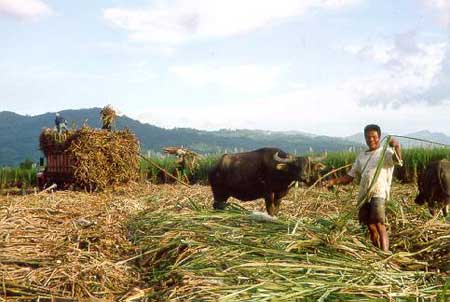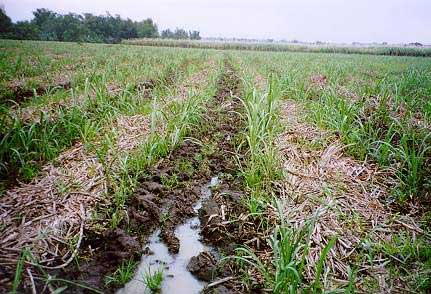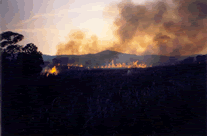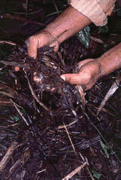Ecological Sugarcane Farming: From Sugarcane Monoculture to Agro-Ecological Village
 |
 |
| Sugar cane trash farming |
For some of the sugar land communities of Negros, however, there is a positive transformation underway. One such community is the Flora community near Kabankalan in southern Negros Occidental. In 1997, through the Philippine government's Comprehensive Agrarian Land Reform Program (CARP), 76 hacienda workers and their families (approximately 375 people) were awarded an 87 hectare former sugarcane plantation, which they divided into individual farms of 0.82 hectares, and a collective farm of 17.7 hectares. The CARP land transfer and community organizing was facilitated by the Paghida et sa Kauswagan Development Group (PDG). The Flora community has since diversified the former hacienda and is following an ecological approach to increase its food self-reliance and make more efficient use of its production capacity.
 |
|---|
| Cane burning causes serious environmental degradation in Negros |
 |
|---|
| Decomposing sugarcane trash fixes up to 150 kg of nitrogen/ha and dramatically improves soil fertility |
One objective for the development of ecological sugarcane farming was to identify outstanding varieties with a self-detrashing capacity, drought resistance, ratooning capacity, adaptability to low fertility soils, biological nitrogen fixation (BNF) potential, lodging resistance and provision of high tonnage and high sucrose content. Identification of these varieties with high productivity and minimal N fertilizer requirements were expected to greatly reduce production expenses and Greenhouse Gas (GHG) emissions associated with N fertilizer production and use. At the beginning of the project, six farmer-led adaptability trials (four upland and two lowland) were conducted with 14 sugarcane varieties formerly tested by the Kabuhian Association and the Sugar Regulatory Administration. At each site, approximately four to six varieties were observed to be performing well under ecological sugarcane management. Five of the varieties were identified as possible BNF varieties capable of supplying much of their own nitrogen requirements.
In 2001-2002, the adoption of trash farming and transition to ecological farming systems was undertaken by 144 farmers on Negros with a land base of 170 ha. Farmers were interested in these materials due to their ease of cultivation under ecological sugarcane management practices and the new varieties which were more productive and possessed a higher sugar content than previous plant materials. The farmers in the Flora community are currently using less than half the urea fertilizer of conventional sugarcane growers in the lowlands of Negros. However, with changing cultural practices, the optimal fertilization level is yet to be determined. Farmers are now saving $130/ha through reduced inorganic fertilizer expenditures. This represents a savings equivalent to 14% of the total annual revenues small farmers obtain from sugarcane farming.
From a greenhouse gas perspective, the conservation of sugarcane residues prevents GHG emissions from the burning process, sequesters carbon in soils and fixes nitrogen during the decomposition process replacing the need for, and GHG emissions from, fossil fuel based nitrogen fertilizer sources. In addition, the combination of BNF varieties with ecological sugarcane management practices encourages high carbon sequestration and atmospheric methane consumption in soils. Analysis of the Greenhouse Gas cycle identified that 9.67 tonnes/ha/yr of CO2e are being reduced with the implementation of trash farming in conjunction with the use of biological N fixing varieties. This large reduction results from turning the sugarcane crop form a source to a sink for greenhouse gases through enhancing soil carbon organic matter levels and encouraging methane oxidizing bacteria.
Through modified sugarcane cultivation, ecological sugarcane farming is enhancing the quality of life of farmers while reducing their environmental impact. The health of the community has improved as the people have secured a reliable and diverse source of food. The new approach has resulted in a system of labour that better matches the working capacity of the community. Since cane detrashing usually occurs during the rainy season when labour demand is low, it enables farmers to divide work throughout the year. Additionally, relative to sugarcane monocultures, the community's diversified agricultural production offers many more opportunities for the involvement of women in all aspects of food cultivation, including cane detrashing, seed collection, planting, marketing and value-added processing. The community's approach also reduces greenhouse gas emissions through the elimination of crop residue burning and minimized reliance on fossil fuels.
In Negros, men and women that were traditionally marginalized are becoming full participants in the region's economy. Rising income levels amongst the rural poor increase demand for basic consumer goods, and higher education for children. The combination of agrarian land reform and the ecologisation of monoculture production systems in Negros thus appears to have the potential to create socio-economic benefits beyond those at the farm production level. Although the Flora Agro-Ecological village is still evolving, it already seems to provide a promising model as a development strategy for communities dependent on monoculture agriculture systems.
Additional information on Sugarcane Farming can be found in the on-line library.
Other Philippine Activities include:
- Development Projects using the Agro-Ecological Village Model
- The Mayon Turbo Stove (MTS): Reducing Poverty and Greenhouse Gas Emissions in the Philippines
- Development of ECO-RICE for increased rice productivity




